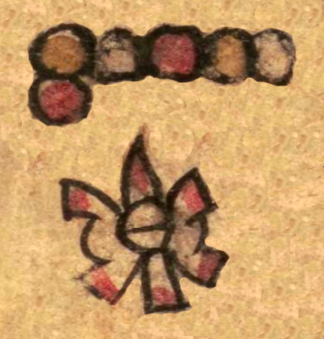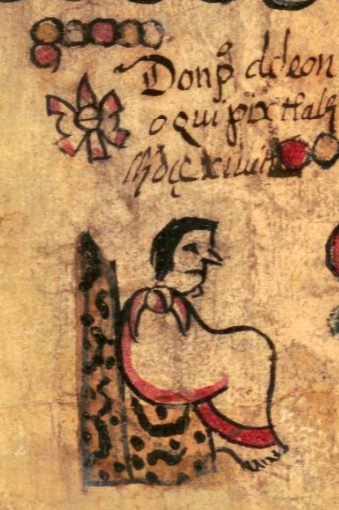Chicuace Olin (CQ)
This simplex glyph plus notation represents the personal name glyph Chicuace Olin, Six Movement. It consists of, at the top, a row of five small circles, and a sixth circle below the left-most circle in the horizontal row. Beginning with the lowest circle and moving up and to the right, the color scheme for these small circles is a pattern, red-yellow-white, red-yellow-white. Below the notation is the glyph for olin (movement), which has a shape something like a butterfly. The olin sign has a wing on the left and on the right, both primarily white but with red on the outer edges. It also has a central axis, pointed at the top and with a circle in the middle. This middle circle on the axis has a black-line, horizontal diameter.
Stephanie Wood
This day sign comes from the tonalpohualli, the 260-day divinatory calendar. Calendrics figure importantly in Mesoamericans' religious views of the cosmos.
Fitting of a governor tlahtoani), the man with this name sits of a jaguar-skin covered throne (icpalli), and he wears a red-trimmed white cape that is tied at his shoulder. According to Sebastián van Doesburg (see our Bibliography) Six Movement (Chicuace Olin) was a ruler who was married to Thirteen Deer (Matlactli Omei Mazatl). They governed for about 36 years, from 1528 to 1563. Living as he did in the Spanish colonial context, Six Movement also bore the name don Pedro de León. This is a name that is mentioned frequently in the Anales de Tecamachalco.
Stephanie Wood
covers ruling men and women of Tecamachalco through 1593
Stephanie Wood
six, seis, movimiento, movement, earthquakes, temblores, terremotos, xiuhpohualli, año, turquesa, xihuitl

Seis Movimiento, o 6-Movimiento
Stephanie Wood
The Codex Quetzalecatzin, aka Mapa de Ecatepec-Huitziltepec, Codex Ehecatepec-Huitziltepec, or Charles Ratton Codex. Library of Congress. https://www.loc.gov/item/2017590521/
The Library of Congress, current custodian of this pictorial Mexican manuscript, hosts a digital version online. It is not copyright protected.


